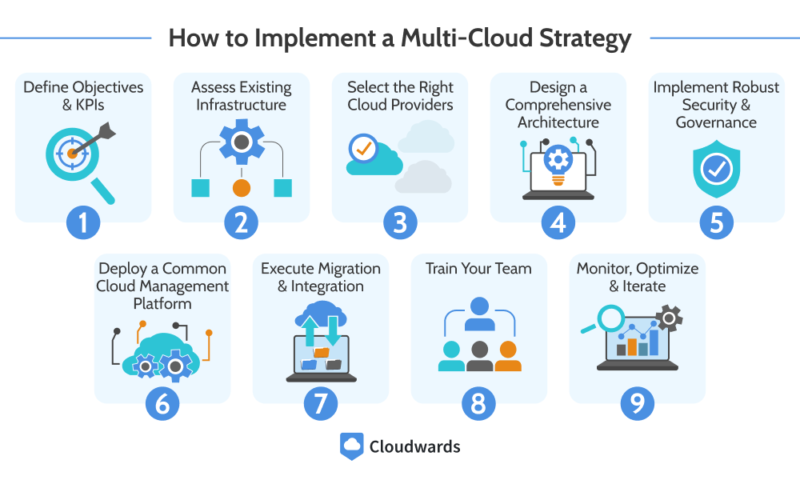What Is a Multi-Cloud Strategy? Your Guide on How to Implement It
To ensure optimal results, a multi-cloud strategy must be thorough and precisely implemented. This guide compares hybrid cloud and multi-cloud solutions while discussing the benefits of multi-cloud computing.
In some environments, one cloud provider doesn’t cut it, which requires you to spread your services across multiple cloud computing platforms. The inherent advantage here is that, with a multi-cloud strategy, you won’t be putting all your eggs in one basket.
This guide discusses multi-cloud deployment, focusing on how to implement the strategy, plus explaining the benefits and key components of multi-cloud computing. It also offers a comparison between hybrid cloud and multi-cloud computing.
What Is a Multi-Cloud Strategy?
A multi-cloud strategy is a cloud deployment approach that involves using services across multiple cloud providers. In this case, the cloud providers could be public, private or a combination of both.

One goal of a multi-cloud strategy is synergy, where the combined strengths of multiple cloud platforms offer a better experience than sticking to a single platform’s suite of services. It also ensures you’re not overdependent on one provider, which would make your cloud environment somewhat inflexible.
Multi-Cloud vs Hybrid Cloud
While both cloud deployment approaches involve different cloud computing environments, multi-cloud and hybrid cloud are different. The multi-cloud approach combines the services of multiple cloud providers, while hybrid cloud combines private and public cloud resources. We share an overview of the differences between these approaches below.
| Multi-Cloud | Hybrid Cloud | |
|---|---|---|
| Definition | Multi-cloud combines services across multiple cloud provider platforms | Hybrid cloud integrates private and public cloud resources for reasons such as enhanced security and compliance |
| Infrastructure | Multi-cloud uses primarily public cloud providers. It does not require private cloud services, but you can use them in your environment | Hybrid cloud uses private and public cloud providers |
| Flexibility | Multi-cloud offers more flexibility as you can use as many cloud providers as you want | Hybrid cloud focuses more on balancing the security of private cloud with the scalability of public cloud |
| Security | Multi-cloud offers data security and operational resilience by preventing a single point of failure | Hybrid cloud gives you more control over sensitive data by deploying it in a private cloud |
| Management | The client has fewer responsibilities since the public cloud providers handle much of the management | The client has more responsibilities because of the private cloud component |
What Are the Benefits of Multi-Cloud Computing?
The benefits of multi-cloud computing include flexibility, cost optimization, increased resilience and vendor lock-in avoidance.
- Flexibility and best-of-breed services: Multi-cloud computing allows you to access the best services across multiple cloud provider platforms. This prevents your operations from becoming inflexible due to the limits of one cloud provider.
- Vendor lock-in avoidance: Vendor lock-in comes from an overdependence on one cloud provider. By adopting multi-cloud deployment, you won’t be confined to one provider’s technologies and pricing, leading to a more flexible cloud environment.
- Enhanced disaster recovery and high availability: The chances of multiple cloud providers failing at the same time are pretty low. Therefore, spreading your workloads across multiple regions and cloud providers increases the durability and availability of your cloud environment.
- Cost optimization: When adopting multi-cloud, you can compare the prices of similar services for multiple providers and opt for those that offer a balance between pricing and performance.
- Improved performance and reduced latency: With multi-cloud, you can use different cloud providers to distribute your workloads across data centers that are closest to end users, reducing latency and enhancing performance.
- Compliance and data sovereignty: Compliance and data sovereignty regulations require user data to be stored and processed in certain ways. With multi-cloud, you can readily distribute workloads across platforms that meet your compliance needs.
- Scalability and agility: Multi-cloud computing enhances your ability to scale resources up or down since you’re no longer confined to one platform’s limitations. It also provides a world of resources to support changing business needs.
- Increased resilience: With your workload distributed across multiple platforms, your cloud environment becomes more resilient — when one provider has downtime, you can shift to another platform to ensure business continuity.
What Are the Disadvantages of Multi-Cloud Computing?
Multi-cloud computing can be complex because of the diversity of cloud platforms, and this can also open your multi-cloud environment to security risks. We provide additional details about these disadvantages of multi-cloud computing below.
- Complexity: Different cloud computing platforms offer markedly different experiences, including billing, service features, naming, compatibility and level of abstraction. For this reason, if you’re combining two or more cloud platforms in a multi-cloud environment, fitting their services in together can be complicated.
- Security risks: When used alone, many cloud providers offer more than enough security, but when different providers are combined, newer security risks arise. One reason for this is that when connecting multiple cloud providers in a multi-cloud environment, you have to create extra network connections (including internet connections), which ultimately increase attack surface.
- Personnel costs: Multi-cloud computing requires highly skilled personnel for successful implementation and smooth operation. For this reason, you may incur the costs of training your team or employing highly-skilled professionals.

but there are some disadvantages.
How to Implement a Multi-Cloud Strategy
To implement a multi-cloud strategy, you need clear objectives and performance indexes to design your strategy. Apart from that, you must evaluate your existing infrastructure to determine what resources you need.

1. Define Objectives and KPIs
When defining objectives and key performance indicators (KPIs) for your multi-cloud strategy, you’ll want to ask the question, “Why are we adopting multi-cloud?” Your objectives could involve increased resilience, enhanced compliance and cost optimization. Once you’ve defined your objectives, craft KPIs around them.
2. Assess Your Existing Infrastructure
While transitioning to multi-cloud, you should assess your existing infrastructure to gain insight into your current on-premises or cloud resources. Once you know what you already have, you can identify the resources you need to achieve your objectives.
3. Select the Right Cloud Providers
Your assessment of your existing infrastructure will guide your cloud provider selection. In other words, knowing what your current cloud provider or on-premises infrastructure offers will help you choose cloud providers that can supplement your existing cloud infrastructure.
4. Design a Comprehensive Architecture
You’ll need a comprehensive design to ensure near-faultless interoperability of your multi-cloud architecture. To achieve this, ensure consistent operations across platforms for easier management and create a central management system to enhance visibility. You should also implement security features like cloud-agnostic tools to address multi-cloud security challenges.
5. Implement Robust Security and Governance
Multiple cloud environments lead to a broader attack surface, so you’ll also need robust security. When setting up security for multi-cloud, ensure consistency across all environments. Apart from that, you need a centralized security system for enhanced visibility, along with integrated detection and response.
Besides security features, you must have a compliance framework since compliance may differ per platform. Furthermore, you should implement data management, access and identity policies as tracking data across multiple providers will be complex.
6. Deploy a Common Cloud Management Platform
For seamless interoperability, deploy the same cloud management platform across your multi-cloud environment. This cloud management platform will let you optimize your resources and costs, improve and monitor performance, and ensure security and compliance all in one place.
7. Execute Migration and Integration
Once everything is in place, you can start migrating your workloads to your multi-cloud environment. Doing a phased migration will help minimize downtime. To ensure an organized process, use a separate strategy for applications and data migration.
For your applications to integrate and communicate across all platforms, you’ll need application programming interfaces (APIs) and middleware. To achieve unified deployment, use automation and orchestration tools like Kubernetes, Docker, Jenkins and GitHub Actions for deployment, provisioning and scaling.
8. Train Your Team
While most cloud platforms have the same basic flow for similar services, knowledge of one cloud platform may not be enough to operate all the others in a multi-cloud environment. You should train your team to handle every provider in your multi-cloud environment.
9. Monitor, Optimize and Iterate
When your multi-cloud environment is up and running, you must monitor it to ensure optimal costs, resource usage, security and performance. The data you gather from monitoring can inform optimization decisions and help you make improvements to the environment.
Key Components of a Multi-Cloud Strategy
The key components of a multi-cloud strategy include migration, security, automation, connectivity and networking, data management and monitoring.
What Types of Services Do Multi-Cloud Solutions Offer?
The use cases of multi-cloud computing are centered around its benefits. For instance, if you want to deliver your application globally, using a multi-cloud system that delivers the app to different regions through the closest cloud provider will reduce latency and enhance performance.
Multi-cloud also allows you to leverage several cloud providers. You can have a multi-cloud environment featuring AWS, Microsoft Azure, Google Cloud and IBM: AWS meets your scalability needs, Azure offers seamless integration with your Microsoft tools, Google Cloud handles your data analysis workloads, and IBM helps with hybrid cloud.
Final Thoughts
A comprehensive multi-cloud strategy guarantees seamless migration, enhanced security and compliance, and efficient operation while ensuring data integrity, central visibility and connectivity. It also encourages continuous optimization based on data accumulated from monitoring.
Do you currently have a multi-cloud strategy? If yes, which components of multiple cloud computing environments discussed in the article will you incorporate? If not, what other multi-cloud strategy component would you add to our discussion? Share your thoughts with us in the comments below. As always, thanks for reading.
FAQ: Multi-Cloud Architecture
Organizations choose multi-cloud as their enterprise cloud strategy for various reasons, including enhanced disaster recovery, optimized costs, increased resilience and avoidance of vendor lock-in.
There is no example of a multi-cloud provider as multi-cloud computing is an approach that users adopt themselves.
Azure hybrid cloud refers to various hybrid cloud solutions that Microsoft Azure offers, including Azure Local, Azure Arc and Azure VMware Solution.
Multi-cloud management platforms are tools that offer a central environment for monitoring, controlling, scouring and optimizing multi-cloud deployments.

